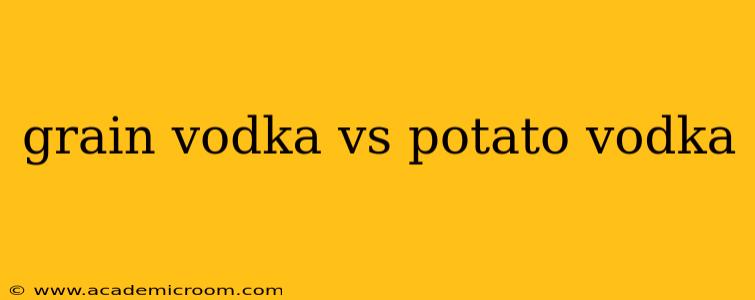The world of vodka can seem surprisingly complex, especially when differentiating between seemingly similar types. Two popular contenders often spark debate: grain vodka and potato vodka. While both ultimately produce a clear, neutral spirit, subtle differences exist in their production, flavor profiles, and overall characteristics. This comprehensive guide will delve into the nuances of grain vs. potato vodka, addressing common questions and helping you choose the best option for your palate.
What is Grain Vodka?
Grain vodka, as the name suggests, is made from various grains such as wheat, rye, corn, or barley. These grains undergo a fermentation process, converting their starches into sugars, which are then fermented into alcohol. The resulting mash is distilled multiple times to achieve the desired purity and neutral flavor profile. Many consider grain vodka to be the more widely available and commonly produced type. The choice of grain can subtly influence the final product's taste, with wheat often yielding a smoother, softer vodka, and rye contributing a spicier, more robust character.
What is Potato Vodka?
Potato vodka, conversely, utilizes potatoes as its primary ingredient. Similar to grain production, the starches within the potatoes are converted into fermentable sugars, and the resulting mash is distilled. Potato vodka is often praised for its naturally smooth texture and slightly creamy mouthfeel. The absence of certain compounds found in grains can result in a less pungent aroma and a cleaner taste, which many find appealing.
What are the Key Differences Between Grain and Potato Vodka?
The key differences lie mainly in the base ingredient and the resulting subtle flavor profiles and textures. Let’s break it down:
-
Base Ingredient: Grain vodka uses various grains (wheat, rye, corn, barley), while potato vodka uses potatoes. This fundamental difference impacts the final product.
-
Flavor Profile: Grain vodkas can exhibit a broader range of flavor profiles depending on the grain used. Some may display subtle sweetness, while others might possess a spicier note. Potato vodkas tend to offer a cleaner, smoother, and potentially creamier taste.
-
Texture/Mouthfeel: Potato vodka often boasts a smoother, slightly creamy mouthfeel, while grain vodkas can vary in texture depending on the grain and distillation process.
-
Price: Generally, grain vodka tends to be more widely available and potentially less expensive than potato vodka. However, this can vary significantly depending on brand and quality.
Does one type have more alcohol content?
No. The alcohol content of vodka, regardless of whether it's grain or potato-based, depends on the distillation process and is typically around 40% ABV (alcohol by volume). The base ingredient doesn't directly dictate the alcohol percentage.
Which type of vodka is best for cocktails?
Both grain and potato vodkas can be excellent choices for cocktails. The best option often depends on the specific cocktail. A smoother potato vodka might be preferred in cocktails where the vodka's flavor should be less prominent, allowing other ingredients to shine. A grain vodka with a more distinct character could complement cocktails where a subtle spice or sweetness would enhance the drink. Ultimately, personal preference plays a significant role.
Which type of vodka is best for drinking straight?
This is largely a matter of personal preference. Some individuals might find the smoother, creamier texture of potato vodka more enjoyable when sipped neat, while others might prefer the nuanced flavors offered by certain grain vodkas. The quality of the vodka plays a crucial role here, regardless of its base ingredient.
Are there any health differences between grain and potato vodka?
From a purely nutritional standpoint, both grain and potato vodkas are essentially calorie-dense alcoholic beverages with minimal nutritional value. The impact on health is primarily related to alcohol consumption, not the base ingredient. Moderate consumption is always recommended.
In conclusion, while the differences between grain and potato vodka are subtle, they are noticeable to discerning palates. The choice ultimately depends on individual preferences and intended use. Experimenting with both types will allow you to determine your preferred vodka style.
